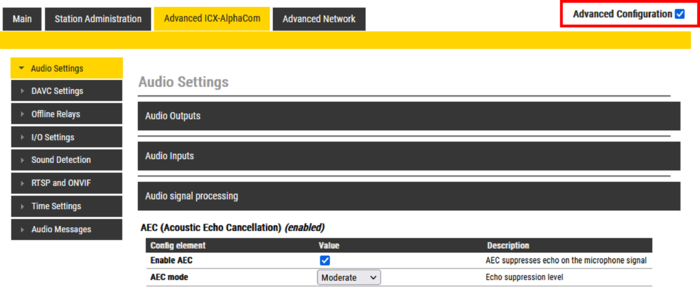Difference between revisions of "Acoustic Echo Cancellation (AEC)"
From Zenitel Wiki
(Created page with "Media:Example.ogg{{AEIS}} '''Acoustic Echo Cancellation (AEC)''' is a feature in the Zenitel IP devices. Acoustic Echo is when you duri...") |
|||
| (One intermediate revision by the same user not shown) | |||
| Line 1: | Line 1: | ||
| − | + | {{AEIS}} | |
'''Acoustic Echo Cancellation (AEC)''' is a feature in the [[:Category:Intercoms and Devices|Zenitel IP devices]]. Acoustic Echo is when you during a call can hear your own voice in return, with more or less volume, and more or less delay. The echo can range from simply annoying to absolutely unbearable, and may result in callers not understanding each other and important information being missed. | '''Acoustic Echo Cancellation (AEC)''' is a feature in the [[:Category:Intercoms and Devices|Zenitel IP devices]]. Acoustic Echo is when you during a call can hear your own voice in return, with more or less volume, and more or less delay. The echo can range from simply annoying to absolutely unbearable, and may result in callers not understanding each other and important information being missed. | ||
| Line 47: | Line 47: | ||
[[Category: IC-EDGE Configuration]] | [[Category: IC-EDGE Configuration]] | ||
[[Category: AlphaCom features]] | [[Category: AlphaCom features]] | ||
| + | [[Category: Audio Settings and Audio Features]] | ||
Latest revision as of 14:33, 25 October 2023
Acoustic Echo Cancellation (AEC) is a feature in the Zenitel IP devices. Acoustic Echo is when you during a call can hear your own voice in return, with more or less volume, and more or less delay. The echo can range from simply annoying to absolutely unbearable, and may result in callers not understanding each other and important information being missed.
The purpose of the AEC feature is to remove this echo. In Zenitel IP Devices the AEC feature is by default active. Zenitel IP intercoms have been calibrated from factory, and the AEC level is by default set to the most suitable value. Hence there is normally no need to alter the default settings.
Some parameters effecting the acoustic echo cancellation:
- Loudspeaker volume
- Microphone sensitivity
- Distance between speaker and microphone
- Mechanical design (e.g. vibrations, speaker and mic mounting)
- Environment (e.g. reflecting surfaces)
Configuring the AEC feature
Configuration is done from the Audio Settings menu. First enable Advanced Configuration mode. Depending on the mode of operations, select:
- Edge mode: Edge Configuration > Audio Settings > Audio signal processing
- SIP mode: SIP Configuration > Audio Settings > Audio signal processing
- ICX-AlphaCom mode: Advanced ICX-AlphaCom > Audio Settings > Audio signal processing
 |
| Acoustic Echo Cancellation configuration menu (firmware 7 and later) |
- Enable AEC: Check the box to enable suppression of echo on the microphone signal. Default enabled. If disabled the loudspeaker and microphone will be open without any audio processing.
- AEC mode: Sets the aggressiveness of the echo suppressor. A higher level trades off double-talk performance for increased echo suppression. Available suppression levels:
- Low
- Moderate
- High
- Half Duplex
With "Half Duplex" the loudspeaker will be muted when speaking into the microphone.
High or Half Duplex can be used in noisy or acoustic challenging environments, or in customized stations without optimal acoustic design, where one is experiencing issues with echo, chopping audio or one-way audio.

|
|

